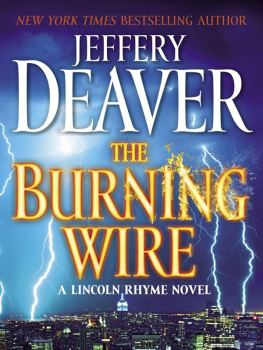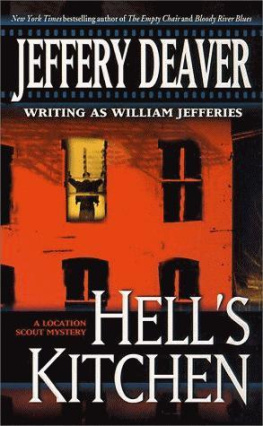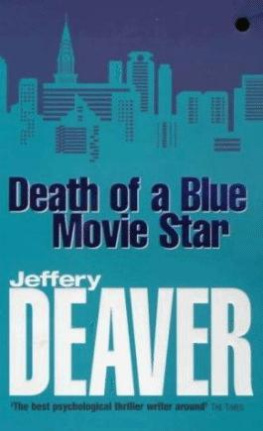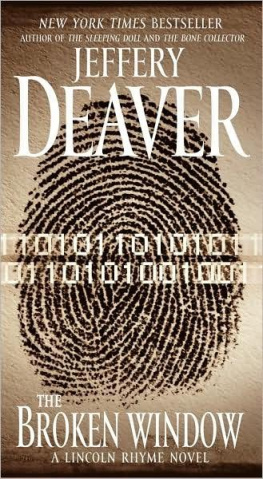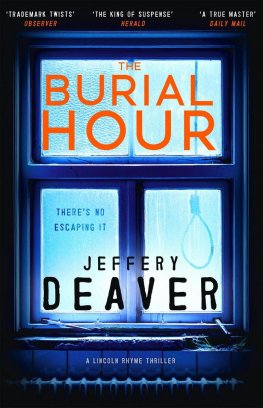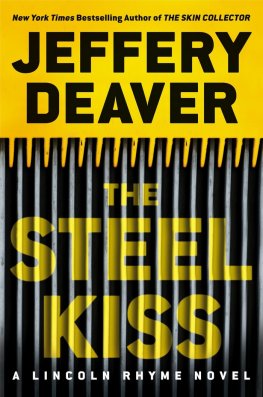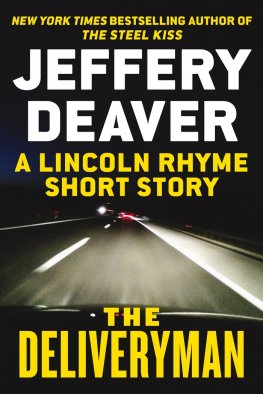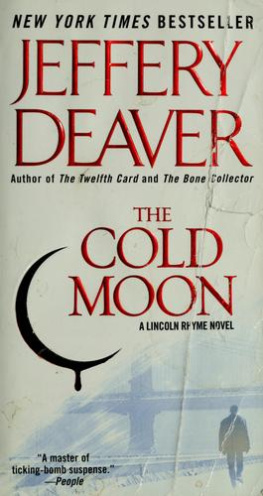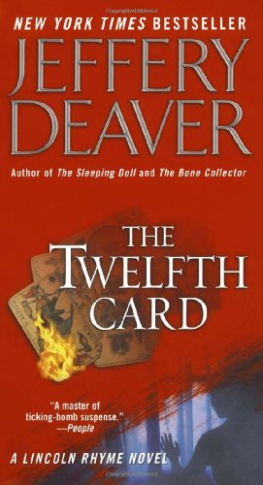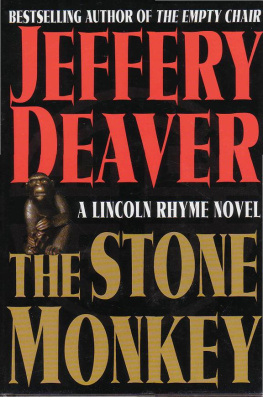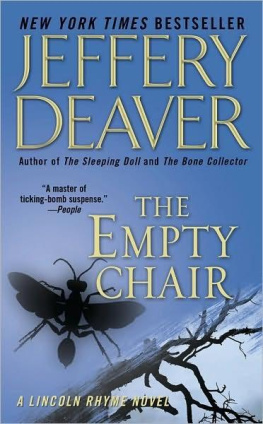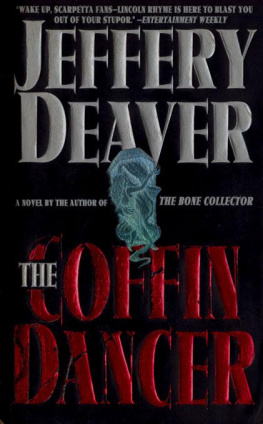
BY THE SAME AUTHOR
Best American Mystery Stories 2009(Editor)
The Watch List(The Copper Bracelet and The Chopin Manuscript)(Contributor)
Roadside Crosses**
The Bodies Left Behind
The Broken Window*
The Sleeping Doll**
More Twisted: Collected Stories, Volume Two
The Cold Moon*/**
The Twelfth Card*
Garden of Beasts
Twisted: Collected Stories
The Vanished Man*
The Stone Monkey*
The Blue Nowhere
The Empty Chair*
Speaking in Tongues
The Devils Teardrop
The Coffin Dancer*
The Bone Collector*
A Maidens Grave
Praying for Sleep
The Lesson of Her Death
Mistress of Justice
Hard News
Death of a Blue Movie Star
Manhattan Is My Beat
Hells Kitchen
Bloody River Blues
Shallow Graves
A Century of Great Suspense Stories(Editor)
A Hot and Sultry Night for Crime(Editor)
Mary Shelleys Frankenstein (Introduction)
*Featuring Lincoln Rhyme and Amelia Sachs
**Featuring Kathryn Dance
THE
BURNING
WIRE
A LINCOLN RHYME NOVEL
JEFFERY DEAVER
Simon & Schuster
NEW YORK LONDON TORONTO SYDNEY

Simon & Schuster
1230 Avenue of the Americas
New York, NY 10020
www.SimonandSchuster.com
This book is a work of fiction. Names, characters, places, and incidents either are products of the authors imagination or are used fictitiously. Any resemblance to actual events or locales or persons, living or dead, is entirely coincidental.
Copyright 2010 by Jeffery Deaver
All rights reserved, including the right to reproduce this book or portions thereof in any form whatsoever. For information address Simon & Schuster Subsidiary Rights Department, 1230 Avenue of the Americas, New York, NY 10020.
First Simon & Schuster hardcover edition June 2010
SIMON & SCHUSTER and colophon are registered trademarks of Simon & Schuster, Inc.
For information about special discounts for bulk purchases, please contact Simon & Schuster Special Sales at 1-866-506-1949 or business@simonandschuster.com.
The Simon & Schuster Speakers Bureau can bring authors to your live event. For more information or to book an event, contact the Simon & Schuster Speakers Bureau at 1-866-248-3049 or visit our website at www.simonspeakers.com.
Manufactured in the United States of America
1 3 5 7 9 10 8 6 4 2
Library of Congress Cataloging-in-Publication Data
Deaver, Jeffery.
The burning wire : a Lincoln Rhyme novel / Jeffery Deaver.
p. cm.
1. Rhyme, Lincoln (Fictitious character)Fiction. 2. PoliceNew York (State)New YorkFiction. 3. Manhattan (New York, N.Y.)Fiction. 4. Serial murderersFiction. I. Title.
PS3554.E1755B87 2010
813'.54dc22
2009049993
ISBN 978-1-4391-5633-9
ISBN 978-1-4391-5896-8 (ebook)
For editor extraordinaire, Marysue Rucci
Hell, there are no rules here. Were trying to accomplish something.
THOMAS ALVA EDISON, ON CREATING
THE FIRST ELECTRIC GRID
Contents
Thirty-seven hours until Earth Day
THE TROUBLEMAN

From his neck down a man is worth a couple of dollars a day, from his neck up he is worth anything that his brain can produce.
THOMAS ALVA EDISON
SITTING IN THE control center of Algonquin Consolidated Power and Lights sprawling complex on the East River in Queens, New York, the morning supervisor frowned at the pulsing red words on his computer screen.
Critical failure.
Below them was frozen the exact time: 11:20:20:003 a.m.
He lowered his cardboard coffee cup, blue and white with stiff depictions of Greek athletes on it, and sat up in his creaky swivel chair.
The power company control center employees sat in front of individual workstations, like air traffic controllers. The large room was brightly lit and dominated by a massive flat-screen monitor, reporting on the flow of electricity throughout the power grid known as the Northeastern Interconnection, which provided electrical service in New York, Pennsylvania, New Jersey and Connecticut. The architecture and decor of the control center were quite modernif the year were 1960.
The supervisor squinted up at the board, which showed the juice arriving from generating plants around the country: steam turbines, reactors and the hydroelectric dam at Niagara Falls. In one tiny portion of the spaghetti depicting these electrical lines, something was wrong. A red circle was flashing.
Critical failure...
Whats up? the supervisor asked. A gray-haired man with a taut belly under his short-sleeved white shirt and thirty years experience in the electricity business, he was mostly curious. While critical-incident indicator lights came on from time to time, actual critical incidents were very rare.
A young technician replied, Says we have total breaker separation. MH-Twelve.
Dark, unmanned and grimy, Algonquin Consolidated Substation 12, located in Harlemthe MH for Manhattanwas a major area substation. It received 138,000 volts and fed the juice through transformers, which stepped it down to 10 percent of that level, divided it up and sent it on its way.
Additional words now popped onto the big screen, glowing red beneath the time and the stark report of the critical failure.
MH-12 offline.
The supervisor typed on his computer, recalling the days when this work was done with radio and telephone and insulated switches, amid a smell of oil and brass and hot Bakelite. He read the dense, complicated scroll of text. He spoke softly, as if to himself, The breakers opened? Why? The loads normal.
Another message appeared.
MH-12 offline. RR to affected service
area from MH-17, MH-10, MH-13, NJ-18.
Weve got load rerouting, somebody called unnecessarily.
In the suburbs and countryside the grid is clearly visiblethose bare overhead high-tension wires and power poles and service lines running into your house. When a line goes down, theres little difficulty finding and fixing the problem. In many cities, though, like New York, the electricity flows underground, in insulated cables. Because the insulation degrades after time and suffers groundwater damage, resulting in shorts and loss of service, power companies rely on double or even triple redundancy in the grid. When substation MH-12 went down, the computer automatically began filling customer demand by rerouting the juice from other locations.
No dropouts, no brownouts, another tech called.
Electricity in the grid is like water coming into a house from a single main pipe and flowing out through many open faucets. When one is closed, the pressure in the others increases. Electricitys the same, though it moves a lot more quickly than waternearly 700 million miles an hour. And because New York City demanded a lot of power, the voltagesthe electrical equivalent of water pressurein the substations doing the extra work were running high.
But the system was built to handle this and the voltage indicators were still in the green.
What was troubling the supervisor, though, was why the circuit breakers in MH-12 had separated in the first place. The most common reason for a substations breakers to pop is either a short circuit or unusually high demand at peak timesearly morning, both rush hours and early evening, or when the temperature soars and greedy air conditioners demand their juice.
Next page
